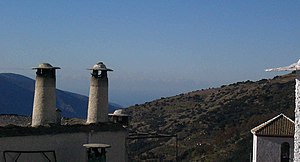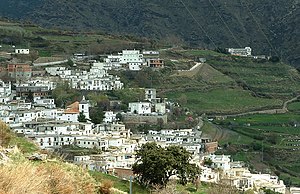
Back البشرات Arabic Alpujarras Breton La Alpujarra Catalan Las Alpujarras Czech Alpujarras German Alpujarras Esperanto La Alpujarra Spanish Alpujarra Basque آلپوجاراس Persian Alpujarras French
This article needs additional citations for verification. (August 2016) |






The Alpujarra (Spanish pronunciation: [alpuˈxara], Arabic: al-bussarat)[1] is a natural and historical region in Andalusia, Spain, on the south slopes of the Sierra Nevada and the adjacent valley.[2] The average elevation is 1,200 metres (4,000 ft) above sea level.[3] It extends over two provinces, Granada and Almería; it is sometimes referred to in the plural as "Las Alpujarras". There are several interpretations of this Arabic-origin name: the most convincing is that it derives from al-basharāt (البَشَرَات),[4] meaning something like "sierra of pastures". The administrative centre of the part in Granada is Órgiva, while that of the part in Almería is Alhama de Almería.
The Sierra Nevada runs west-to-east for about 80 km. It includes the highest mountain in mainland Spain: the Mulhacén at 3,479 metres (11,414 ft) The term sierra nevada implies the existence of a snow field, an accumulation of permanent snow and ice. However, in the Alpujarras most of the snow melts in the spring and summer, allowing the southern slopes of the Sierra to remain green and fertile throughout the year, despite the heat of the summer sun. Water emerges from innumerable springs; human intervention has channeled it to terraced plots and to the villages.
Olives are grown on the lower slopes, and in the valley below which extends from Órgiva to Cadiar, through which flows the Guadalfeo river. The plentiful water, milder climate, and fertile land favour the cultivation of grapes, citrus, and other fruit. There is also a developing production of wine on the hills between this valley and the sea, and almond trees thrive on its southern slopes. The eastern end of the Alpujarra, towards Ugijar in the province of Almería, is much more arid.
- ^ "Toponimia de la provincia y el Valle de Lecrín".
- ^ "Las Alpujarras". www.andalucia.com. 28 June 2011. Retrieved 2014-08-18.
- ^ "Las Alpujarras". www.andalucia.com. 28 June 2011. Retrieved 2014-08-18.
- ^ entry for بشرات in almaany.com
© MMXXIII Rich X Search. We shall prevail. All rights reserved. Rich X Search